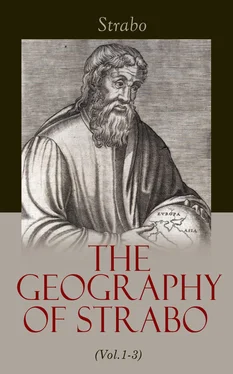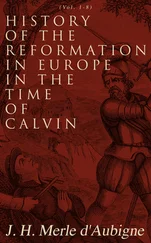32. Next these on this side the Taurus are the mountaineers of Paropamisus, and various tribes of Parthians, Medes, Armenians, Cilicians, with “the Lycaonians,” 899and Pisidians. 900After these mountaineers come the people dwelling beyond the Taurus. First amongst these is India, a nation greater and more flourishing than any other; they extend as far as the Eastern Sea 901and the southern part of the Atlantic. In the most southerly part of this sea opposite to India is situated the island of Taprobana, 902which is not less than Britain. Beyond India to the west, and leaving the mountains [of the Taurus] on the right, is a vast region, miserably inhabited, on account of the sterility of its soil, by men of different races, who are absolutely in a savage state. They are named Arians, and extend from the mountains to Gedrosia and Carmania. 903Beyond these towards the sea are the Persians, 904the Susians, 905and the Babylonians, 906situated along the Persian Gulf, besides several smaller neighbouring states. On the side of the mountains and amidst the mountains are the Parthians, the Medes, the Armenians, and the nations adjoining these, together with Mesopotamia. 907Beyond Mesopotamia are the countries on this side the Euphrates; viz. the whole of Arabia Felix, bounded by the entire Arabian and Persian Gulfs, together with the country of the Scenitæ and Phylarchi, who are situated along the Euphrates and in Syria. Beyond the Arabian Gulf and as far as the Nile dwell the Ethiopians 908and Arabians, 909and next these the Egyptians, Syrians, and Cilicians, 910both those styled Trachiotæ and others besides, and last of all the Pamphylians. 911
33. After Asia comes Libya, which adjoins Egypt and Ethiopia. The coast next us, from Alexandria almost to the Pillars, is in a straight line, with the exception of the Syrtes, the sinuosities of some moderately sized bays, and the projection of the promontories by which they are formed. The side next the ocean from Ethiopia up to a certain point is almost parallel to the former; but after this the southern portions become narrowed into a sharp peak, extending a little beyond the Pillars of Hercules, and giving to the country something the figure of a trapezium. Its appearance, both by the accounts of other writers, and also the description given to ourselves by Cnæus Piso, who was governor of this province, is that of a panther’s skin, being dotted over with habitations surrounded by parched and desert land: these habitations the Egyptians call Auases. 912This continent offers besides several other peculiarities, which may be said to divide it into three distinct portions. Most of the coast next us is very fertile, more especially about the Cyrenaic and the parts about Carthage, as far as Maurusia and the Pillars of Hercules. 913Next the ocean it is likewise tolerably fitted for the habitation of man; but not so the centre of the country, which produces silphium; 914this for the most part is barren, rugged, and sandy; and the same is the case with regard to the whole of Asia lying under the same right line which traverses Ethiopia, the Troglodytic, 915Arabia, and the part of Gedrosia occupied by the Ichthyophagi. 916The people inhabiting Libya are for the most part unknown to us, as it has rarely been entered, either by armies or adventurers. But few of its inhabitants from the farther parts come amongst us, and their accounts are both incomplete and not to be relied on. The sum of what they say is as follows. Those which are most southern are called Ethiopians. 917North of these the principal nations are the Garamantes, the Pharusians, and the Nigritæ. 918Still farther north are the Gætuli. Close to the sea, and adjoining it next Egypt, and as far as the Cyrenaic, dwell the Marmaridæ. 919Above 920the Cyrenaic and the Syrtes 921are the Psylli and Nasamones, 922and certain of the Gætuli; and after them the Asbystæ 923and Byzacii, 924as far as Carthage. Carthage is vast. Adjoining it are the Numidæ; 925of these people the tribes best known to us are called the Masylies and the Masæsylii. The most westerly are the Maurusians. 926The whole land, from Carthage to the Pillars of Hercules, is fertile. Nevertheless it abounds in wild beasts no less than the interior; and it does not seem improbable that the cause why the name of Nomades, 927or Wanderers, was bestowed on certain of these people originated in their not being able anciently to devote themselves to husbandry on account of the wild beasts. At the present day, when they are well skilled in hunting, and are besides assisted by the Romans in their rage for the spectacle of fights with beasts, they are both masters of the beasts and of husbandry. This finishes what we have to say on the continents.
34. It now remains for us to speak of the climata. 928Of these too we shall give but a general description, commencing with those lines which we have denominated elementary, namely, those which determine the greatest length and breadth of the [habitable earth], but especially its breadth.
To enter fully into this subject is the duty of astronomers. This has been done by Hipparchus, who has noted down (as he says) the differences of the heavenly appearances for every degree of that quarter of the globe in which our habitable earth is situated, namely, from the equator to the north pole.
What is beyond our habitable earth it is not however the business of the geographer to consider. Nor yet even in regard to the various parts of the habitable earth must too minute and numerous differences be noticed, since to the man of the world they are perplexing; it will suffice to give the most striking and simple of the statements of Hipparchus. Assuming, as he does himself after the assertion of Eratosthenes, that the circumference of the earth is 252,000 stadia, the differences of the [celestial] phenomena will not be great for each [degree] within the limits between which the habitable earth is contained. Supposing we cut the grand circle of the earth into 360 divisions, each of these divisions will consist of 700 stadia. This is the calculation adopted by [Hipparchus] to fix the distances, which [as we said] should be taken under the before-mentioned meridian of Meroe. He commences at the regions situated under the equator, and stopping from time to time at every 700 stadia along the whole length of the meridian above mentioned, proceeds to describe the celestial phenomena as they appear from each. But the equator is not the place for us to start from. For even if there be there a habitable region, as some suppose, it forms a habitable earth to itself, a narrow slip enclosed by the regions uninhabitable on account of the heat; and can be no part of our habitable earth. Now the geographer should attend to none but our own habitable earth, which is confined by certain boundaries; on the south by the parallel which passes over the Cinnamon Country; 929on the north by that which passes over Ierna. 930But keeping in mind the scheme of our geography, we have no occasion to mark all the places comprehended within this distance, nor yet all the celestial phenomena. We must however commence, as Hipparchus does, with the southern regions.
35. He tells us that the people who dwell under the parallel of the Cinnamon Country, which he places at 3000 stadia south of Meroe, 931and 8800 [north] of the equator, live nearly at equal distances between the equator and the summer tropic which passes by Syene; for Syene is 5000 stadia [north] of Meroe. They are the first 932for whom the whole [constellation] of the Lesser Bear is comprised within the Artic Circle, and to whom it is always visible. For the bright and most southern star, at the tip of the tail, is here contained within the Arctic Circle, and appears to touch the horizon.
The Arabian Gulf lies eastward parallel to the said meridian. Its egress 933into the Exterior Ocean is [in the same latitude as] the Cinnamon Country, the place where anciently they used to hunt the elephants. The parallel of the Cinnamon Country on the one side 934passes a little south of Taprobana, or perhaps over its southern extremity; and on the other side 935over the most southern parts of Libya. 936
Читать дальше












![Anne Blunt - A Pilgrimage to Nejd, the Cradle of the Arab Race. Vol. 2 [of 2]](/books/750183/anne-blunt-a-pilgrimage-to-nejd-the-cradle-of-the-thumb.webp)